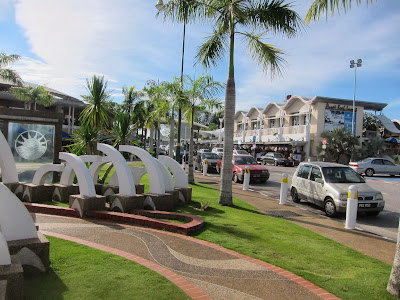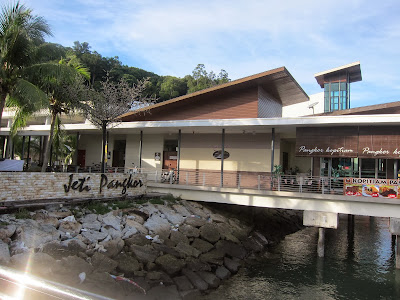After our chicken breakfast in Taiping, we drove west to the small rustic town of Kuala Sepetang - a.k.a Port Weld. Port Weld was about 20 km away. This remote almost forgotten town in the midst of rivers and mangrove, is really quite interesting and has a few attractions to offer.
As we approached the town, the scenery on both sides of the road changed. We saw tall slim trees - very unlike the typical Malaysian forest. We were in mangrove country.
Just before entering town, we turned right off the main road to visit the Hutan Paya Laut Matang (Matang Mangrove Forest Reserve). This is large forest reserve comprising nearly 102 hectares of mangrove swamp and is home to many flora and fauna species of the coastal ecosystem.
The mangrove trees were a pretty sight. The forest was beautiful and unspoilt.
There was a very long wooden walkway through the forest. As we walked through the trees, we enjoyed a cool atmosphere in spite of the mid morning sun. Below us was the wet muddy land of the swamp forest. The place was serene and peaceful. But where were the visitors? The place was largely deserted. Inclusive of the 3 of us, there were hardly 10 people there.
There were several chalets for rent to holiday makers. We did not get to see the inside of the chalets. I imagined they would be comfortably furnished.
They even had a large community hall, complete with a large stage.
But I don't know if that was a good idea. The forest was nice and beautiful. It definitely was worth the visit. But to stay there for a night or two? There was absolutely nothing to do. No wonder none of the chalets was occupied.
This was a nice jetty at the forest reserve. They apparently organise boat trips for fishing and sight-seeing...
... on the pristine Sungei Reba.
From the Matang Mangrove Forest Reserve, we drove into Port Weld (Kuala Sepetang) town to look for food. Alan remembered a seafood place beside the river.
We found it. It was appropriately named Kedai Makanan Tepi Sungei (literally translated - food place beside the river).
The restaurant was located above a fish processing plant where fishermen bring in their catches.
We walked up a flight of stairs..
... passed a huge kitchen..
... and arrived at a small dining area. I wondered why they needed such a big kitchen for a small restaurant.
It was a charming place. I liked it immediately. We were on the upper floor of a building at the edge of the Reba river. The atmosphere was cool, quiet and with a great view. Perfect for a relaxing meal.
We overlooked a pristine river. There were fishing boats and river-side dwellings around us. This place reminded me so much of Kuala Selangor.
This was the blanched prawns. They looked drab and pathetic. I was totally disappointed with the dish. There was no complaint about freshness, but they were over-cooked. Blanched prawn should be done just right to keep its juiciness and succulence.
We ordered a plate of boiled see-hum (cockles 鲜蚶) for the heck of it. They were nice. They were not over done. But they did not provide a good sauce for it. I had expected some nice peanut chilli sauce to dip in. They just put an ordinary bottle of chilli sauce on the table.
This was a single mantis prawn. The waitress held her palms about a foot apart to show us the size of it. She told us it would cost us RM36 for the single crustacean. It was deep fried and then cooked in a garlic sauce. It was quite good. Definitely the best dish of the meal. But the foot long prawn did not have much meat. We each had a small morsel - RM12 per bite.
The fish was a snapper steamed in assam sauce. It was hopeless. Again, no complaint on freshness. But the assam sauce was so fake. Eddy said he could make a much better assam fish than this. I felt the same too.
Our vege dish...
In spite of the poor food quality, we enjoyed the meal. It was in a nice place and the mood was so very relaxed. A lot of food for 3 old men. Still we managed to clean up the plates.
After lunch, we drove a short distance and located this historical site.
The first railway line in Malaysia was between Port Weld and Taiping. It was built by the British in 1885. It was 8.5 miles long and built at a cost of just 7,000 pounds. This was the location of the original Port Weld railway station.
Today, the rail station signboard is outside somebody's home in an old Chinese village. The only recognition of the historical significance of the site is a totally out-of-place KTM signage and a info plaque. What a pathetic way to treat a national historical site.
Next, we drove out of town and visited a charcoal factory. Port Weld is apparently famed for its charcoal. Probably because of the abundant mangrove trees there.
I had expected the factory to be filthy, messy and everything associated with black dirty charcoal. But is was not to be. The factory was really quite organised. There were rows of kilns where the charcoal were burnt. Everything was in the proper place. It was a huge place. Surprising there were not many workers.
The charcoal were made from mangrove wood. The wood were harvested from the mangrove forest and apparently brought here via this canal. However, on that day, the canal was dry. I do not know if it was because of the tide.
The wood were cut and stripped of their barks.
They were then burnt in the kilns. The kilns were totally air tight. A fire at the entrance provided the heat. A worker told us the wood were burnt continuously for 32 days. They were then smoked for another 12 days. The whole process took 44 days. The heat and the absence of oxygen in the kiln carbonised the wood in a process known as pyrolysis, and converted them to charcoal.
This was is the end product.
From the charcoal factory, we drove south and arrived at the coastal town of Lumut. It had been a long long time since my last visit here. How things had changed. The infra structure at the harbour area was really quite impressive.
We walked around town. Alan had a problem with his Maxis data SIM card. We stopped at a telco shop. A friendly shop assistant tried to help with no avail. We asked him which was a good restaurant to eat in Lumut. He replied "KFC". It was then we made an impromptu decision to cross over to Pangkor.
Ferry services to Pangkor were frequent. Parking our car was not a problem. There was a large car park for over-nighters, within walking distance from the harbour. The parking lady helped us with hotel selection and booking. It was all very quickly and efficiently done.
The ferry ride to Pangkor was just half an hour.
By the time we checked into our hotel we were tired and thirsty and dying for a beer. Our hotel was totally halal and did not serve alcohol. We took a short walk to the next hotel, located along the beach. The Sea View Hotel is owned and managed by Malaysian Thomas Cup badminton great and golf champion - Datuk Tan Yee Khan.
We chose a table by the beach.
The beer went down very quickly.
It wasn't yet time for dinner. But Eddy said he was hungry. So we ordered a plate of fried mee-hoon. It was delicious.
It was followed by a few other dishes and became our dinner.
We sat there for a long while - eating, drinking, talking. And enjoyed the beautiful sun set.
Later Datuk Tan Yee Khan came to our table to chat with us. He told us stories about his badminton and golf days.
It had been a long and interesting day. We absolutely enjoyed it. We must have more of such trips to no where.


















































No comments:
Post a Comment